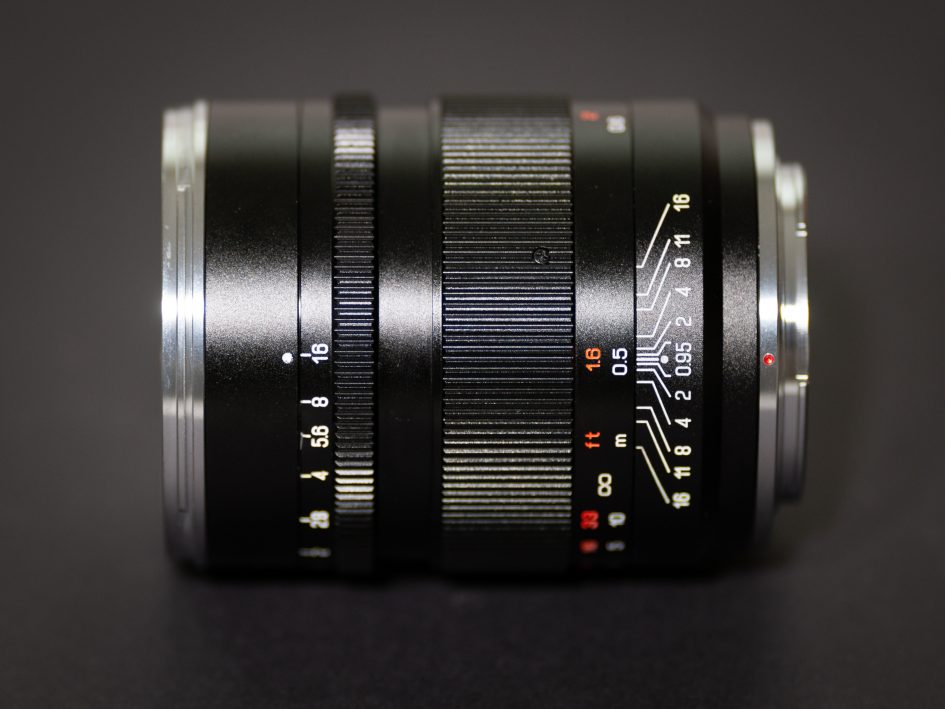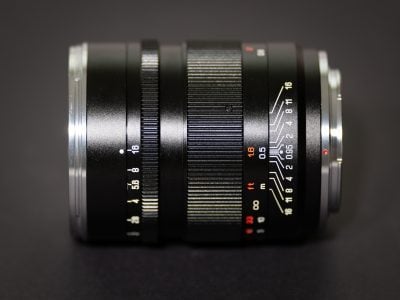Zhongyi Mitakon Speedmaster 50mm f0.95 III review
-
-
Written by Thomas
Verdict
A focal ratio of f0.95 on a lens covering full-frame sensors for only 1000 EUR / 800 USD? That sounds too good to be true – especially as other lenses with the same spec cost around 5 figures. And what do you get? Well, the Mitakon does two things pretty well: it produces a very desirable Bokeh with soft transitions and a creamy rendering of the background when used wide open. Unfortunately Zhongyi has opted for straight aperture blades which produce “edgy” Bokeh balls once you stop the lens down. A strange design decision. The other thing that’s pretty astonishing is the low light fall-off even at f0.95.
What’s not to like? The Mitakon is manual focus only. This may be an absolute no-go for many photographic assignments. But even if you have the time to focus manually I found it not as easy to nail focus than with other, sharper lenses. Which leads straight to the other weakness of this lens: It is soft in the center with strong aspherical aberrations producing a soft veil and purple fringes/halos. Only at f2.0 the center becomes sharp enough to satisfy but resolution still drops visibly even before reaching the edge of the APS-C image-circle. For better acuity off-center you need to stop down to at least f2.8 or even further depending on how important sharpness of peripheral image elements is in your image. And “peripheral” can even mean the eyes of your model in a head-and-shoulder portrait. The Mitakon also has low resistance against flare and glare which makes shooting into strong contra-light a bit risky. And then there is the issue of light transmission: The nominal focal ratio of the lens may be a record f0.95 but in the end the Mitakon transmits 0.4 EV less than expected. That’s almost half a stop of light that does not reach the sensor.
But Zhongyi’s Mitakon Speedmaster is not without alternatives. Let’s have a closer look at how the lens compares to some of them.

Above from left to right: Nikon 58mm f1.4G on Nikon FTZ adapter, Mitakon Speedmaster 50mm f0.95 III, Nikon Z 58mm f0.95 S Noct
Compared to Nikon Z 58mm f0.95 S Noct
The Nikon Z 58mm f0.95 S Noct represents the pinnacle of optics for Nikon’s mirrorless Z system: It boasts the same record f0.95 focal ratio as the Mitakon and enjoys all the latest technology and the best glass Nikon has available. This makes for an extraordinary lens: It combines an excellent optical performance even wide open and at close-up shots plus the best Bokeh I’ve seen so far in a prime lens up to 85mm focal length. And although it’s manual focus only it’s easier to focus than the Mitakon plus it supports all automatic exposure modes, an electrically actuated aperture, and full EXIF data transfer including lens profile data. It also comes with extensive weather sealing plus fluorine coating against moist and dust, a multi-function ring assignable to aperture or exposure compensation, an integrated tripod collar, OLED display, and function button. You might not need the f0.95 aperture but when you use this lens you can produce images that are hard to duplicate with any other model. For these special occasions the Nikon Z 58mm f0.95 S Noct is a unique lens with the best available performance. As such it comes Highly Recommended although it’s extremely expensive and weighs more than twice the Mitakon.
For more details see my Nikon Z 58mm f0.95 S Noct review.
Compared to Nikon 58mm f1.4G
The Nikon AF-S 58mm f1.4G from 2013 is a good lens but it “only” got a Recommended in my review. In many aspects it reminds me of the Mitakon: It is less sharp towards the corners (although better than the Mitakon), has lower contrast wide open, less resistance against flare and glare plus stronger loCA and coma than the Zeiss Otus or Nikon Z Noct. Its Bokeh is not the most pleasing especially in the foreground – a weakness it shares with the Mitakon too. Although to be fair the more important transition zone and background Bokeh is rendered more creamy from the Mitakon at f0.95 than from the Nikon at f1.4. If you already have this F-Nikkor in your collection, you can continue using it via FTZ adapter with good results and enjoy the lighter weight plus autofocus and support for all automatic exposure modes. But I would not recommend buying it for your brand-new Nikon Z body.
For more details see my Nikon AF-S 58mm f1.4G review.
Compared to Zeiss Otus 55mm f1.4
Even 6 years after its introduction the Zeiss Otus is still an excellent performer even wide open at f1.4. This all comes in a package that exudes quality in every aspect of its physical presence: No other lens I’ve tested so far comes close. Compared to the silky smooth action of its focus ring the Mitakon or Z-Noct seem coarse. Optically the Otus has much better corner performance in direct comparison to the Mitakon, less haloing in the center plus less focus breathing. Plus it offers support for all automatic exposure modes, and full EXIF data transfer. But the Otus at f1.4 cannot match the Bokeh of the Mitakon at f0.95 – at least when you look at the transition zone and the background. And the Otus is much bigger and more expensive than the Mitakon. Still it is Highly Recommended as an excellent alternative for those demanding very high performance but don’t need a larger aperture than f1.4.
For more details see my Zeiss Otus 55mm f1.4 review.

Mitakon Speedmaster 50mm f0.95 III final verdict
The Mitakon Speedmaster 50mm f0.95 III is an exotic and unusual lens: one of only three f0.95 models (all manual focus) available for full-frame bodies at the time of writing, and by far the cheapest too. Available in Sony E, Canon RF and Nikon Z-Mounts, it may not attain the optical heights of the considerably more expensive alternatives from Nikon and Leica, but it remains quite a likeable lens none-the-less. It offers a record f0.95 focal ratio in a much smaller and lighter package than the Z-Noct and much cheaper too at around 1000 EUR / 800 USD. The background Bokeh wide open is second only to the Nikon Z Noct and the light fall-off in the corners is astonishingly low for such a large aperture. But it has loads of optical aberrations: coma, astigmatism, spherical aberrations, haloing, low resistance against flare and glare, an ugly foreground Bokeh, not to mention almost half a stop lower light transmission than the Noct in my tests. This all makes it harder to nail focus manually wide open than with other, sharper lenses plus you have to operate the aperture manually too with no EXIF data transfer. But still: if you like the “look” of the Mitakon Speedmaster you can have a lot of fun with it, and again there’s no other full-frame lens with an f0.95 focal ratio anywhere near the price. Recommended.
Good points:
- One of only three full-frame lenses with a record f0.95 focal ratio.
- Relatively low price.
- Very good Bokeh at f0.95 with smooth transition zone and creamy background.
- Distortions mostly corrected through lens profile.
- Relatively little light fall-off for such a large aperture lens.
Bad points:
- Light transmission around 0.4 EV lower than expected.
- Soft center wide open with purple halos.
- Mushy corners up to f2.8 with strong coma and astigmatism.
- Straight aperture blades produce “edgy” Bokeh balls when stopped down.
- Low resistance against flare and glare.
- No weather sealing.
- Manual focus only, hampered by soft rendering.
- Manual aperture actuation only, no (EXIF) data transmission.
- Visible focus breathing.
Check prices on the Mitakon Speedmaster 50mm f0.95 III at Amazon, B&H or Adorama. Alternatively get yourself a copy of my In Camera book or treat me to a coffee! Thanks!




